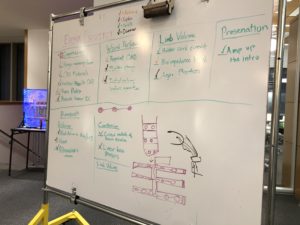Update #8: Week of Feb 24
 This week, we took a step back and focused on researching current solutions and brainstorming new approaches to various parts of our project. Below is a task list of how we divided up the research.
This week, we took a step back and focused on researching current solutions and brainstorming new approaches to various parts of our project. Below is a task list of how we divided up the research.

Compression:
We contacted Hanger Prosthetics to ask for soft, medium, and hard grade memory foam. We plan to use this memory foam to improve our current prototypes and test them for uniform compression. Last week, when we tested the rigid compression sleeve printed with ABS filament, we observed that this design had more compression on the edge of the limb stump and more compression in the middle. We hope that using a more flexible material will make the applied pressure more uniform. Consequently, we would like to try using flexible SLA resin to 3D print our rigid compression sleeve. However, the build plates of the SLA resin printers on campus are too small to print our 5 inch by 5 inch sleeve. We need to re-design our sleeve so that two halves of the sleeve can be printed separately and put together like puzzle pieces.
Finally, we are currently researching different force sensors and pressure sensors to get quantitative readings of the applied pressure. We are also researching current methods of actuation to learn how we can improve our current air bladder and memory foam prototypes.
Wound Perfusion:
We plan to re-print the CAD holder for the spO2 sensor because the dimensions were a little too big. We also need to look for and order a flexible strap (like a backpack strap) to adhere to the spO2 sensor so it can easily be slid on and off the limb stump. Additionally, based on peer team feedback and advice from Dr. Walker from our meeting last week, we are researching a way to validate that our spO2 readings of the limb stump are accurate.
Limb Volume:
We are waiting for the conductive rubber cords, which we ordered 2 weeks ago, to come in so we can make a Wheatstone bridge circuit to measure limb volume. We are also continuing to research how to use the bioimpedance board. We have made good progress in attaining a Windows 7 computer and using the bioimpedance board software to figure out how we are going to use it to get readings on an agar phantom.
Presentation
Since we wrote our presentation introduction months ago before we really understood the scope of our project, we want to amp up our intro to better explain our project. Now, the background specifies that our device focuses on helping amputees immediately post-operation and we emphasize how important proper prosthetic fitting is for good wound healing.